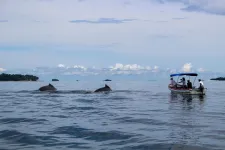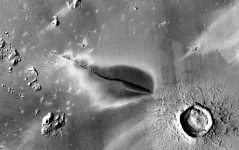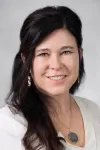INFORMATION:
Informed tourists make whale watching safer for whales
2021-05-10
(Press-News.org) According to the International Whaling Commission, whale-watching tourism generates more than $2.5 billion a year. After the COVID-19 pandemic, this relatively safe outdoor activity is expected to rebound. Two new studies funded by a collaborative initiative between the Smithsonian Tropical Research Institute (STRI) in Panama and Arizona State University (ASU) show how science can contribute to whale watching practices that ensure the conservation and safety of whales and dolphins.
"The Smithsonian's role is to provide scientific advice to policy makers as they pioneer management strategies to promote whale conservation," said STRI marine biologist, Hector Guzmán, whose previous work led the International Maritime Organization to establish shipping corridors in the Pacific to prevent container ships from colliding with whales along their migration routes. "Now we have methods to measure how whale behavior changes as a result of whale-watching practices. These two papers were published in a special volume of Frontiers in Marine Science dedicated to studies of whale-watching practices worldwide."
Whale watching is on the rise around the world and is part of sustainable tourism-development projects in countries such as Cambodia, Laos, Nicaragua and Panama. But critics say that jobs and increased income for tour operators and coastal residents cannot be justified if whales are harmed.
Whale-watching regulations in Panama first established with Guzman's help in 2005, and modified in 2017 and 2020, prohibit activities that cause whales to change their behavior. The aim of the first study was to discover if the presence of tourism boats caused the whales to change their behavior during the breeding season.
Researchers monitored humpback whales (Megaptera novaeangliae) during their August-September breeding season within Panama's Las Perlas Archipelago protected area. From a high vantage point on Contadora Island and from whale-watching vessels, they recorded the number of tourist boats and whales present and activity, including changes in direction, breaching, slapping the water, dives and spy-hops (raising the head above the water surface) on 47 occasions.
They discovered that whale-watching vessels frequently disregarded legal guidelines designed to protect the whales: deliberately chasing whales, getting too close to adult whales and calves, and forcing whales to change their behavior. Other notable observations included:
Tourist boats chased groups that included calves more often than groups of adults.
Groups that included a calf changed direction more often than did other group types.
Whales changed direction more often when more than two to three tourist boats were present.
Roughly 1,000 whale watchers visit the Las Perlas islands each year, and that number is growing. In the second study, researchers interviewed tourists waiting to return to the mainland at the Contadora airport to better understand the whale watching experience. They interviewed every third person waiting in line.
Ninety-nine percent of the tourists who saw whales reported seeing at least one behavior while whale watching, and 68% reported that their experience met or exceeded their expectations. 30% said that they did not observe a whale. Half reported that they had observed either their boat or other nearby boats chasing whales at high speed, or that they had gotten closer to the whales than the distance permitted by law.
Breeding whales are threatened by marine pollution, ship strikes, climate change, noise and disturbances while they are resting, socializing and feeding. In the future, researchers hope to measure the amount of cortisol (a stress hormone) in whale fecal samples to find out if the animals are under stress, use better technology (e.g., theodolites--instruments that measure angles) to measure the distance between boats and whales, use drones with cameras to document interactions and continue to survey tourists to better understand whale watching and inform management strategies to keep these magnificent animals safe.
"I wanted to do a study with practical outcomes for conservation, not just another paper that sits on a shelf," said Katie Surrey, doctoral candidate at ASU and co-author of both papers. "In Las Perlas, where whales come to breed, we observed harassing behavior, like ten tourist boats surrounding a single mother and calf. But we also talked to tourists and operators who learned a significant amount about whales and champion better whale-watching practices and conservation efforts as a result. For my dissertation I plan to find out more about what motivates both the tourists and the operators, so that we can suggest ways to both improve their experience and safeguard the whales."
ELSE PRESS RELEASES FROM THIS DATE:
Solving the cocktail party problem
2021-05-10
Conducting a discussion in a noisy place can be challenging when other conversations and background noises interfere with our ability to focus attention on our conversation partner. How the brain deals with the abundance of sounds in our environments, and prioritizes among them, has been a topic of debate among cognitive neuroscientists for many decades.
Often referred to as the "Cocktail Party Problem", its central question focuses on whether we can absorb information from a few speakers in parallel, or whether we are limited to understanding speech from only one speaker at a time.
One ...
Controlling cholesterol in microglia alleviates chronic pain, opioid-free
2021-05-10
Chemotherapy can induce a painful peripheral neuropathy (CIPN), a chronic condition and common adverse effect for cancer patients undergoing treatment. Researchers at University of California San Diego School of Medicine, with colleagues elsewhere, have used a mouse model to demonstrate the pivotal role of cholesterol in CIPN, and proposed a novel therapeutic approach to reverse it.
The findings are published in the May 10, 2021, online issue of the Journal of Experimental Medicine.
The study was a collaboration between the laboratories of senior study author Yury Miller, MD, PhD, professor of medicine, and Tony Yaksh, PhD, professor of anesthesiology and pharmacology, both at UC San Diego School of Medicine. ...
Volcanoes on Mars could be active
2021-05-10
Evidence of recent volcanic activity on Mars shows that eruptions could have taken place in the past 50,000 years, according to new study by researchers at the University of Arizona's Lunar and Planetary Laboratory and the Planetary Science Institute.
Most volcanism on the Red Planet occurred between 3 and 4 billion years ago, with smaller eruptions in isolated locations continuing perhaps as recently as 3 million years ago. But, until now, there was no evidence to indicate Mars could still be volcanically active.
Using data from satellites orbiting Mars, researchers discovered a previously unknown volcanic ...
The formation of the Amazon Basin influenced the distribution of manatees
2021-05-10
All three species of manatee now present on Earth share a common ancestor from which they split some 6.5 million years ago, when a huge lake in Amazonia, then linked to the Caribbean, was cut off from the sea. The African manatee Trichechus senegalensis is not as genetically close to the West Indian manatee T. manatus as was thought, and adaptation to this complex environment by the Amazonian manatee T. inunguis has left at least one mark in its genetic code.
These are key findings of a study supported by FAPESP and published in Scientific Reports, with hitherto unknown details of the evolutionary history of these aquatic mammals. The authors are an international group of scientists led by researchers at the University of Campinas ...
CHEST releases updated guidelines to diagnose and evaluate hypersensitivity pneumonitis
2021-05-10
The American College of Chest Physicians® (CHEST) recently released new clinical guidelines on the Diagnosis and Evaluation of Hypersensitivity Pneumonitis (HP). The guidelines contain 14 evidence-based recommendations to improve individual diagnostic decision-making and to decrease diagnostic practice variability.
Occurring at any age, HP is an immunologically mediated form of lung disease resulting from inhalational exposure to a large variety of environmental and/or occupational inciting antigens (typically fungal, bacterial, avian). Over the years, the categorization of HP based on clinical features and disease duration coupled with traditional diagnostic criteria has been unhelpful, even when accurate, when separated from a probabilistic diagnostic ...
Invasive species alters marine community, interferes in post-disaster recovery
2021-05-10
Clavelina oblonga, an invasive marine fouling species, not only reduces diversity in communities it invades, it also interferes in their recovery following natural disasters - a process known as "succession."
Succession refers to how an ecosystem recovers after a disturbance or natural disaster - does the system come back more or less the same as it was in terms of species composition, or is it different?
"The classic example of succession is a forest that experiences a wildfire," says Kayla Christianson, former NC State graduate student and first author of a paper describing the research. "As the community recovers from the fire, it proceeds through a predictable pattern of community development - starting with grasses and ending with trees and a mature forest. This ...
Early screening tool leads to earlier diagnosis and treatment for autism spectrum disorder
2021-05-10
Since it debuted in 2011, the Get SET Early program, which provides pediatricians and parents with a relatively simple process to screen for indicators of autism spectrum disorder (ASD) in children as young as age 1, has steadily grown in use and validation. Early screening and identification of ASD has been linked to more effective treatment.
A new study, published in the April 26, 2021 issue of the END ...
Researchers use arcuate organoids to study development and disease of the hypothalamus
2021-05-10
PHILADELPHIA-- Human brain organoids are remarkable platforms for modeling features of human brain development and diseases. Building on methods to generate organoids to model different brain regions such as the cortex and the midbrain, researchers at the Perelman School of Medicine at the University of Pennsylvania have generated the first organoids of the arcuate nucleus (ARC), an essential structure in the hypothalamus that sends signals of hunger and feeling full. This part of the hypothalamus exhibits a tremendous amount of cell diversity, and is far more complex than previously modeled parts of the brain.
In a paper ...
New mapping technique reveals epigenetic drivers of cancers
2021-05-10
Scientists have made major advances in understanding and developing treatments for many cancers by identifying genetic mutations that drive the disease. Now a team led by researchers at Weill Cornell Medicine, NewYork-Presbyterian and the New York Genome Center (NYGC) has developed a machine learning technique for detecting other modifications to DNA that have a similar effect.
The study, published May 10 in Cancer Discovery, a journal of the American Association for Cancer Research, focuses on a type of chemical modification to DNA, called methylation, that typically silences nearby genes. The new technique can analyze the thousands of DNA methylation changes detected in tumor cells and infer which ones are likely ...
Single-cell map of early stage lung cancer and normal lung sheds light on tumor development, new therapeutic targets
2021-05-10
HOUSTON - Researchers at The University of Texas MD Anderson Cancer Center have developed a first-of-its-kind spatial atlas of early-stage lung cancer and surrounding normal lung tissue at single-cell resolution, providing a valuable resource for studying tumor development and identifying new therapeutic targets. The study was published today in Cancer Discovery, a journal of the American Association for Cancer Research.
The findings reveal a heterogeneous lung cancer ecosystem, with extensive interactions between cancer cells and the surrounding microenvironment that regulate early cancer development. ...




